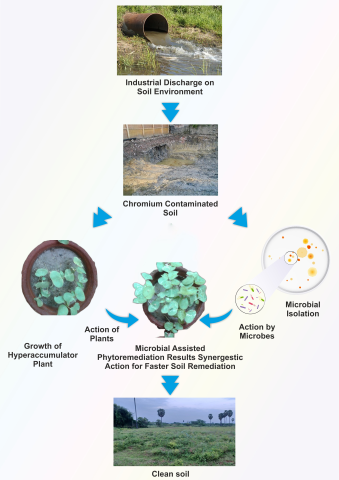You are here
Synergistic effects of microbes and plant for remediation of chromium contaminated soil

The contamination of soil is a serious issue to the environment caused by the human activities in the form of improper disposal methods. There are several contaminated dumpsites in India where, hazardous and other wastes contains heavy metal were dumped historically, which subsequently results in the contamination of soil, surface and subsurface water, and land. One of such heavy metal pollutant is Chromium. There are many conventional methods available for reclaiming soil and water which are contaminated by chromium and other heavy metals. However the biological or bioremediation technique is the most widely used method for in-situ application.In this experimental study, the synergistic action between the plants and bacteria for effective remediation of chromium contaminated site was studied. This study aims to address the capability of reduction of chromium (VI) by bacterial strain and to assess the synergistic linkage between the plants and the microbes. Under laboratory conditions, the bacteria that was isolated from the chromium-contaminated soil was able to withstand upto 500 mg/L of Cr (VI). By, 16S rRNA method, Staphylococcus saprophyticus bacterium was identified. The SDS PAGE analysis showed that the reductase enzyme was expressed during the chromium remediation process by Staphylococcus saprophyticus. The synergistic action between plants the selected plants like Napier grass, Cotton, Sorghum, Nerium and Jatropha and the identified Staphylococcus saprophyticus was studied. The research shown that the synergistic effects raise the chromium accumulation and enhance the plant biomass, root length, and shoot length. The higher accumulation was found in the roots than leaves. The accumulation was found to be in the order of Napier grass (229.955 mg/kg) > Cotton (179.98 mg/kg) > Nerium (116.353 mg/kg) > Jatropha (84.735 mg/kg) > Sorghum (61.71 mg/kg) in control plants. The combination of Napier grass and Staphylococcus saprophyticus shows the best combination for chromium reduction. In view of this the synergistic action of plants and bacteria helps in accumulation of higher concentration of chromium without causing any toxic effects to the plant. Apparently it enhances the efficiency of bioremediation process and can be successfully applied for the reclamation of chromium contaminated sites.
